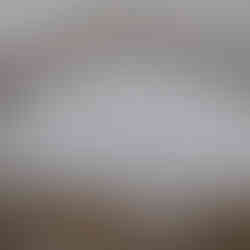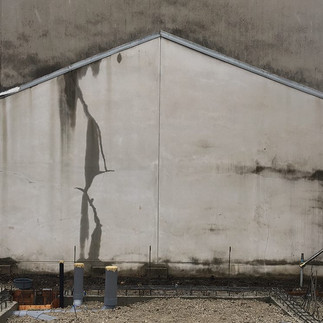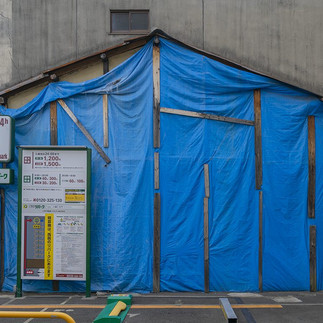"Typology for Traces of Gable Roofs" by Shosuke Miyake.
- 谷口 純弘
- Mar 23, 2021
- 4 min read
We are pleased to present "TYPOLOGY EVERYWHERE," a typology series that originated with Cone and the city.
TYPOLOGY is a method of study that attempts to understand the essence of individual phenomena and forms by extracting similarities between them. In the world of photographic expression, Becher and his wife are famous for arranging water towers and silos, which were becoming industrial heritage in the late 1950s, in the same composition as much as possible. Today, with smartphones in everyone's hands, anyone can take on the challenge of typological approaches without even trying. Typology is everywhere. It's just a matter of being aware of it. Here, I would like to introduce the typology of people who take pictures on various themes.
The memorable first installment is "Typology for Traces of Gable Roofs" by photographer Shosuke Miyake. The traces of demolished townhouses scattered throughout Kyoto, once typified by Genpei Akasegawa as "Thomason," take on new meaning when compared to the history of development in Kyoto. In an interview with Gallery Japanesque at the Kyoto Museum of Photography, we can see Miyake's awareness of Becher and his stoic pursuit of typology, such as waiting for cloudy weather to align the angle of view and the amount of light.
For chignitta, Mr. Miyake prepared "Traces of Gable Roofs" in three different tones. Please enjoy them.
A book of his works is now on sale from Akaasha.
Statement by Shosuke Miyake, "Typology for the Traces of Gable Roofs
In Kyoto, decrepit machiya houses are being demolished and vacant lots are appearing here and there.
On the outer walls of the buildings facing the vacant lots, there are traces of the roofs of neighboring houses that once stood there.
The traces of the roof of the house next door, which once existed, are carved on the outer wall of the building facing the vacant lot, reminding us of the daily life that may have been lived under that roof.
Five years ago, my father passed away and I had to dispose of my parents' house in Kobe.
The house was built in the 1950s on land reclaimed from the foot of Mount Maya.
Now, the land has been cleared and new houses have been built, and there is no trace of what it once was.
On the one hand, I feel refreshed that it is gone without a trace, but on the other hand, I wish it were in Kyoto.
To be honest, I don't have much resistance to the loss of the atmosphere of the ancient Kyoto townscape and its cruel appearance.
In fact, I find it rather abusive that the city is being transformed into a theme park by applying a heavy layer of make-up in order to attract inbound demand, as if we are eating the legacy of our ancestors.
People and towns, when they are alive, sometimes show their ugliness.
As time goes by, the traces of people's activities overlap, and the layers are torn apart in places, creating a patchwork-like appearance.
I am rather attracted to such Kyoto.
A song floating in the depths of the stagnation will never cease to disappear or be tied up for a long time.
People and their homes in the world are just like this.
Kamo Chomei, "Hojoki
Profile of Shosuke Miyake
In 1970, as a first year student at Kyoto University of Arts, I was shocked by conceptual art and Mono-ha when I saw the Tokyo Biennale, for which Yusuke Nakahara was the commissioner.
I also felt uncomfortable with the alley-oop, blur, and out-of-focus photography that was in full swing at the time, but when I came across "Anonymous Sculpture: Typology of Industrial Buildings" (1970) by Becher and his wife, I felt a great deal of sympathy. It was around this time that I learned about Sakumi Hagiwara's "Traces of Time" (1971), in which he made a fixed-point observation of an apple rotting over the course of a year.
Since then, he has avoided reflecting the traces of his hands or his own inner life in his works, and has tried to neutralize himself through repetitive processes.
The stoicism of the art world in the 1970s was replaced by the sudden appearance of the new painting boom in the 1980s, which led to a period of despair.
CV
1950 Born in Kobe, Japan
1976 Completed Fine Arts Course, Kyoto City University of Arts
Solo Exhibitions
1974, 75, 77, 79, 80, 81, 83, 88 Gallery 16 and others
2018 "Ungeziefer" Gallery 16
2018-20 Typology for Traces of Gable Roofs I,II,III LUMEN Gallery
2021 Typology for Traces of Gable Roofs Kyoto Museum of Photography
Group Exhibition
1972, 89, 90, 95 OUR WORKS Exhibition, Osaka Contemporary Art Center, etc.
1973 Isao Tanaka and Shosuke Miyake Exhibition, Three Dimensional Gallery Sagittarius
1974 Nobuo Kobayashi and Shosuke Miyake, Shinanobashi Gallery, Tokyo
1977 Nobuo Kobayashi and Shosuke Miyake 2 Artists Exhibition, Tamura Gallery, Tokyo
1979 Experiment - Method and Development of 34 Artists Kyoto Municipal Museum of Art
1982 Plane Conflicts, Kobe Contemporary Art Gallery
2017 Shosuke Miyake x Hideki Fujimoto / 1974→2017 Kyoto Saga University of Arts
2017-2020 Kyoto Photo Exhibition Gallery Maronie
2018,19,21 COLOR PARTY WEST Irolimra
Public Exhibition
1974 Osaka Fumin Gallery Opening Commemorative Art Competition Exhibition
1982 The 3rd Japan Graphic Exhibition
1989 JPS (Japan Professional Photographers Society) Exhibition
1997 Osaka Triennale 1997 Print
1998 '98 ABC Art Competition
1998, 99 Contemporary Japanese Art Exhibition
2000 Krakow International Print Triennial
2001 Yoshihara Jiro Prize Art Competition
2018 JPS (Japan Professional Photographers Society) Exhibition
2019 HIJU GALLERY-Open Exhibition
Awards
1997 The 5th Printz 21 Grand Prix Exhibition, Runner-up Prize
1998 The 13th Contemporary Japanese Painting Exhibition, Honorable Mention
1998 Excellent Prize, Kyoto Arts and Crafts Exhibition
1999 Kyoto Exhibition, Prize of Kyoto Exhibition
2000 Mr. Q Prize, Sapporo International Print Biennale
2002 The 17th Kyoto Art Festival International Exchange General Exhibition, Chinese Consulate-General Prize































































コメント